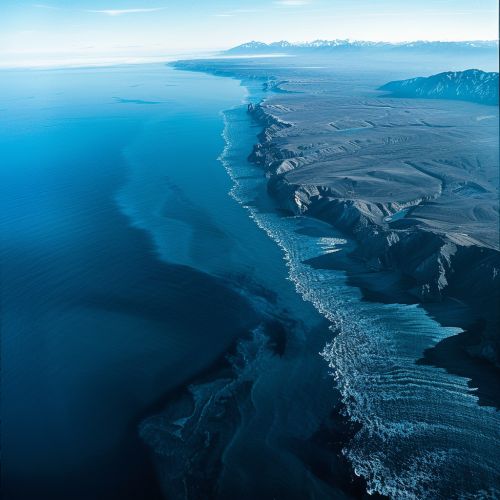Kuril–Kamchatka Trench
Overview
The Kuril–Kamchatka Trench is a subduction zone located in the northwest Pacific Ocean. It extends from the southern tip of the Kamchatka Peninsula in the north to the northern part of the Kuril Islands in the south, a distance of approximately 2,100 kilometers. The trench is the result of the Pacific Plate subducting beneath the Okhotsk Plate, a process that has been ongoing for millions of years.


Geological Characteristics
The Kuril–Kamchatka Trench is characterized by its great depth and length. It reaches a maximum depth of approximately 10,500 meters in the Challenger Deep, making it the second deepest point in the world's oceans after the Mariana Trench. The trench's width varies, but it is generally around 70 kilometers wide. The trench is also characterized by its steep slopes, which can reach angles of up to 45 degrees.
The trench is associated with a number of significant geological features. For instance, it is flanked by a chain of active volcanoes known as the Kuril-Kamchatka volcanic arc, which is part of the larger Ring of Fire. This volcanic arc is a direct result of the subduction process, as the descending Pacific Plate melts and rises to the surface, creating magma that fuels the volcanoes.
Seismic Activity
The Kuril–Kamchatka Trench is one of the most seismically active areas in the world. It is the site of frequent earthquakes, many of which are of high magnitude. The trench has been the location of several significant earthquakes in recorded history, including the 1952 Kamchatka earthquake, which had a magnitude of 9.0 and triggered a destructive tsunami.
The seismic activity in the Kuril–Kamchatka Trench is directly related to the subduction of the Pacific Plate beneath the Okhotsk Plate. As the Pacific Plate descends into the mantle, it causes intense pressure and heat, leading to frequent earthquakes and volcanic eruptions.
Biological Significance
Despite the extreme conditions in the Kuril–Kamchatka Trench, it is home to a variety of marine life. The trench's deep-sea environment is characterized by high pressures, low temperatures, and complete darkness. Yet, it hosts a diverse array of organisms, including many species of deep-sea fish and invertebrates. These organisms have adapted to survive in the trench's harsh conditions, often developing unique physiological features.
The trench also plays a significant role in the larger marine ecosystem. For instance, it influences ocean currents and nutrient distribution, which in turn affect the distribution and abundance of marine life in the surrounding waters.
Exploration and Research
The Kuril–Kamchatka Trench has been the subject of scientific exploration and research for many years. Initial explorations focused on mapping the trench and understanding its basic geological characteristics. More recent research has focused on studying the trench's seismic activity and deep-sea ecology.
Despite the challenges associated with exploring such a deep and remote part of the ocean, scientists have made significant discoveries about the trench. These findings have not only increased our understanding of the Kuril–Kamchatka Trench itself, but also contributed to our broader knowledge of plate tectonics, deep-sea biology, and earthquake prediction.
